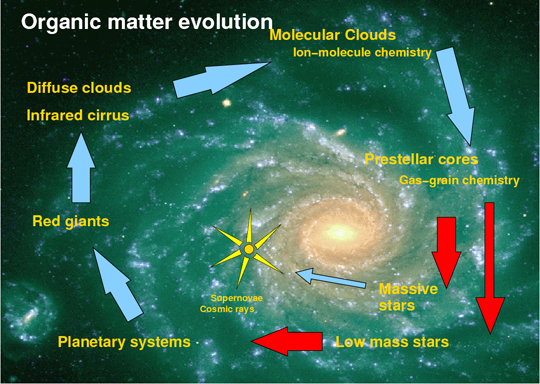Presentation
The “Astrochemistry and Origins” (A&O) team studies the composition of the solid extraterrestrial matter from its formation in the protoplanetary disk to its evolution on the surface of bodies in the Solar System (small primitive bodies; comets and asteroids but also icy bodies, mainly trans-Neptunian objects). For this, the team combines laboratory experiments and measurements with observational data from various space instruments, in order to interpret them.

Three main types of experiments are carried out by the members of the A&O team: (i) physico-chemical characterization measurements of different types of samples, (ii) experimental simulations aiming to reproduce in the laboratory an astrophysical process or environment and to study its physical and/or chemical effects on different types of solid matter, and (iii) experiments to produce analogues of extraterrestrial matter (ice, minerals, organic materials).
The team's analytical methods are based primarily on spectroscopy, microscopy, and imaging techniques used to analyze various extraterrestrial samples: meteorites, interplanetary dust particles (commonly called IDPs) collected in the stratosphere, as well as cometary and asteroid grains collected by space probes and brought back to Earth.
To produce and/or analyze a wide range of samples of astrophysical interest, the A&O team has made the strategic choice to:
1/ develop spectroscopic and physicochemical analyses on devices located at the IAS,
2/ build strong interdisciplinary, national and international, collaborations, to extend its analysis capabilities with national platforms, large accelerators, and synchrotrons (the team has developed a long-standing partnership with the SMIS beamline of the SOLEIL synchrotron, it thus benefits from guaranteed access to the line's instruments and is also developing collaborations with other lines).
The spectroscopic data obtained in the laboratory by the A&O team are made available on the DAYSY database (Database for AstrochemistrY and SpectroscopY) which is part of the SSHADE architecture (Solid Spectroscopy Hosting Architecture of Databases and Expertise), labeled Europlanet (responsible B. Schmitt, IPAG, OSUG) https://www.sshade.eu/db/daysy. This database ensures archiving, traceability and allows public access to a significant part of the experimental data produced by the team.



